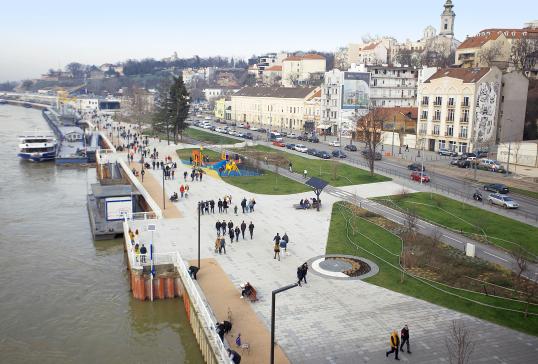- Topic
- Mobility management
- Monitoring and evaluation
- Country
- Serbia
- Resource type
- Case study
First published on 25 May 2021.
Belgrade, the Serbian capital and one of the most populated metropolitan cities of the Balkan region, was one of the finalists of the 9th SUMP Award, alongside the Greater Grenoble Area Mobility Authority (SMMAG) (FR) and Bilbao (ES). It earned this honour as a result of showing a clear and ambitious goal to implement its Sustainable Urban Mobility Plan (SUMP) despite a lack of quality infrastructure for active and sustainable modes of transport.
Although the share of public transport in terms of the total number of trips is relatively high (almost 50%), that is not a reflection of the quality of public transport, but a reflection of its economic and social living conditions. Goals and measures have been set in the city's first SUMP for improvement to the quality of public transport services, and the development of infrastructure for active modes of transport.
Context
The Serbian capital, Belgrade, with a population of more than 1.3 million inhabitants faces several challenges when it comes to commuter traffic. The city's transport system is very complex and, as such, has great potential. However, the monocentric development of the urban area, with a high concentration of workplaces, healthcare and educational facilities in Belgrade’s centre, leads to excessive traffic on radial approaches. The primary traffic corridors of the urban region are under-developed, the traffic management system is technologically outdated and there is a lack of purpose-built parking spaces outside of the centre. The potential of the river Danube crossing the city centre is also currently neglected for both passenger and freight transport.
In action
In order to address the many challenges that the capital is facing transport-wise, the city administration set up a SUMP that offers solutions to fulfil locals’ future mobility needs in a sustainable way. Belgrade’s SUMP is currently in its adoption phase. The city plans to prioritise pedestrian movements while retaining (or even increasing) their modal share (25%) in the coming period by improving pedestrian infrastructure. Besides supporting pedestrian movement, the city aims to boost the modal share of cycling, which currently stands at 0.75%, while maintaining the high share of public transport and reducing passenger car use (20%) by improving the quality of public transport services.
Improving accessibility for all user groups, and securing their safety, is also high on the agenda, as well as reducing harmful emissions from transport, thus increasing the attractiveness and quality of the urban environment. Enabling the balanced development of all of Belgrade's municipalities and to improve their mutual as well as their wider, regional connections is also key to a sustainable transport system in the city. Achieving these goals will require:
- a modal shift away from passenger car use to a higher cycling modal share;
- the development of infrastructure for electromobility;
- a denser and more flexible public transport network; and
- the establishment of a Mobility-as-a-Service system that offers users a personalised package of multimodal mobility services to ensure the sustainability of the transport system.
Results
As discussed, the modal share of public transport is almost 50% in Belgrade, which is the result of many efforts to curb the use of passenger cars. This has included the promotion of social justice and equality in transport and making public transport and public places accessible and safe for all users, including ethnic minorities, senior residents, persons with different racial backgrounds, persons accompanying infants or persons with pets. The programme for the integration of vulnerable groups includes the provision of free public transport tickets and the free use of public bicycles, which helps the city to maintain and further develop a high sustainable mobility modal share.
The basis of an integrated transport system is public transport where integration can be delivered through physical and tariff integration. A developed network of urban-suburban public transport lines in Belgrade serves the terminals and stops of other modes of public transport, and so connects the terminals with certain city zones. Tariff integration among the subsystems of public transport contributes to the dynamics of the system and directly impacts the modal split of motorised trips by increasing the number of public transport users. The passenger public transport system has achieved full tariff integration among all its subsystems through the use of tickets from the so-called “Bus Plus” system.
Challenges, opportunities and transferability
Belgrade’s SUMP development has a long way to go in order to meet every target that it has been set. However, the holistic approach that is in place makes this achievable. One of the missed opportunities in making the modal share more sustainable is the higher participation of pedestrians and cyclists in the share of modes. The action plan for the development of pedestrian infrastructure prescribes upgrades to at least 10-15 km of pedestrian areas per year. The SUMP plans the construction of 493 km of cycle paths in the next 10 years (currently there are 102 km).
In order to make targets realistic, Belgrade set up three scenarios as to how the city’s sustainable urban mobility future can be viewed starting from its current state: “do nothing”, “do something’’ and “do everything”, all closely linked to specific modal split scenarios. If Belgrade strictly follows the road set in its SUMP in the next decade, the “do everything” scenario will become a reality.
In Depth
Ognjen Petar Todorović (Secretariat of Transport) - ognjen [dot] todorovic beograd [dot] gov [dot] rs (ognjen[dot]todorovic[at]beograd[dot]gov[dot]rs)
beograd [dot] gov [dot] rs (ognjen[dot]todorovic[at]beograd[dot]gov[dot]rs)
Facebook page of Belgrade’s SUMP Plan
SUMP Finalist video

